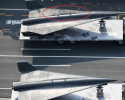Unmanned vehicles formations at the parade (based on Chinese sources):
Formation I (recon): 2x WZ-8, 3x BZK-008A artillery spotting, 3x BZK-008 (aka CH-91) reconnaissance, 3x Ryu Ying (aka Sky Saker FH500)
Formation II (strike): 1x GJ-11 Li Jian (Sharp Sword), 1x GJ-2 Wing Loong II, 4x JWS-01 (copy of IAI Harpy)
Formation III (special): 6x BZK-008A ELINT, 3x BZK-008A EW jammer, 2x HSU-001 robotic mini-sub
Formation I (recon): 2x WZ-8, 3x BZK-008A artillery spotting, 3x BZK-008 (aka CH-91) reconnaissance, 3x Ryu Ying (aka Sky Saker FH500)
Formation II (strike): 1x GJ-11 Li Jian (Sharp Sword), 1x GJ-2 Wing Loong II, 4x JWS-01 (copy of IAI Harpy)
Formation III (special): 6x BZK-008A ELINT, 3x BZK-008A EW jammer, 2x HSU-001 robotic mini-sub










